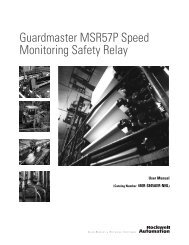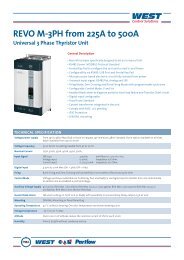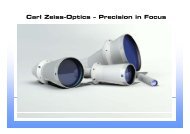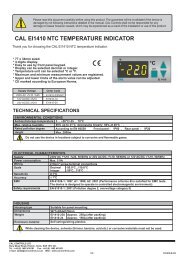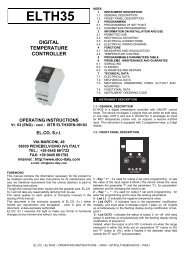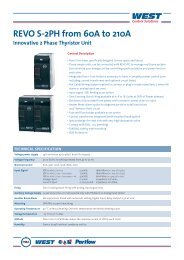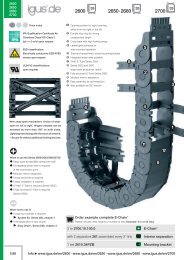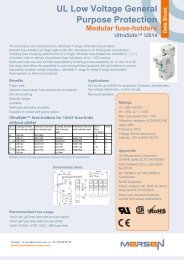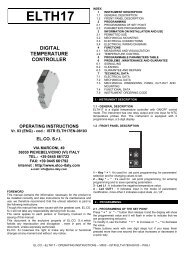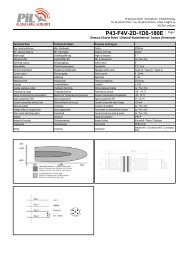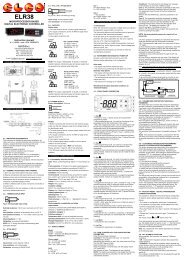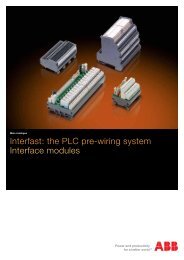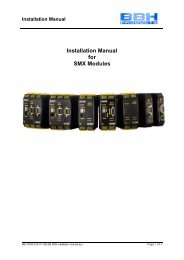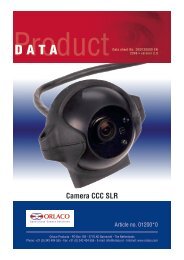Next Generation: GSR Guardmaster Safety Relays - OEM Automatic ...
Next Generation: GSR Guardmaster Safety Relays - OEM Automatic ...
Next Generation: GSR Guardmaster Safety Relays - OEM Automatic ...
Create successful ePaper yourself
Turn your PDF publications into a flip-book with our unique Google optimized e-Paper software.
Safeguarding Applications andWiring Diagrams<br />
SensaGuard<br />
SensaGuard, CI, 800F, 100S<br />
+24V DC<br />
Shown Open<br />
24V DC Com<br />
Brown<br />
SensaGuard<br />
440N-Z21S26H<br />
Cordset<br />
889D-F8AB-2<br />
SensaGuard<br />
SensaGuard<br />
2 3 7 1 4 8 5 6 2 3 7 1 4 8 5 6 2 3 7 1 4 8 5 6<br />
Green<br />
Blue<br />
White (Aux)<br />
Yellow<br />
Red<br />
Gray (OSSD1)<br />
Pink (OSSD2)<br />
Machine Control<br />
PLC Input<br />
(1756-IB16<br />
1769-IQ16<br />
1746-IB16<br />
1792-IB16<br />
1734-IB4<br />
1793-IB6<br />
or similar)<br />
I0<br />
I1<br />
I2<br />
I3<br />
Com<br />
Auxiliary<br />
Signals<br />
to Machine<br />
Control<br />
System<br />
A1 S11 S12 L11 13<br />
RESET 0<br />
RP<br />
CI<br />
AM<br />
440R-S13R2<br />
S21 S22 S34<br />
MM<br />
A2 14<br />
K1<br />
23<br />
Start<br />
800FM-<br />
F3MX10<br />
Stop<br />
800FM-<br />
E4MX01<br />
24<br />
K2<br />
33<br />
44<br />
41<br />
42<br />
K1<br />
K2<br />
100S-C43DJ22BC<br />
K1<br />
K2<br />
L1L2 L3<br />
M<br />
Circuit Status<br />
The first and third gates are closed. The second gate is open. The CI safety relay S12 and S22 inputs are open due to the open gate, and therefore,<br />
the CI safety outputs are open. The machine control PLC has a 24V auxiliary signal at terminal I1 from the second gate because the gate is open.<br />
The first and third auxiliary signals are off, as their gates are closed. The PLC also has an auxiliary signal from the CI indicating that the safety<br />
system is not ready. The motor is off.<br />
Operating Principle<br />
STARTING: Closing the second gate satisfies the input of the CI. The CI verifies that both K1 and K2 contactors are off and energizes its safety<br />
outptus. Pressing the start button energizes the motor. The Stop/Start circuit is not part of the safety system and can be replaced by the machine<br />
control system (e.g., a PLC).<br />
STOPPING: Press the Stop button to turn the motor off, without affecting the status of the safety system. Opening any of the gates will cause the<br />
safety system to stop the motor.<br />
Fault Detection<br />
Upon successful completion of internal checks on power up, the SensaGuard interlocks check for 24V at pins 4 and 8. If the actuator is within<br />
range, the SensaGuard will activate its OSSD outputs. The OSSD outputs perform continuous checking for short circuits to 24V, ground and<br />
crossfaults. Upon detection of a fault, the OSSD outputs turn off. The CI also performs internal checks on powerup. It then checks for input<br />
signals. If OK, the CI checks the K1/K2/S34 monitoring circuit to determine whether both contactors are off. If one of the contactors gets stuck<br />
on, the other contactor will de-energize the motor, and the CI will detect the fault at the next attempt to start the motor. The contactors have<br />
mechanically linked auxiliary contacts to help ensure fault detection of the contactors.<br />
Ratings<br />
This safety performance of this circuit meets the requirements of SIL CL 3 per IEC 62061:2005 and has Category 4 structure and can be used in<br />
systems requiring Performance Levels up to PLe per ISO 13849-1:2008. The SensaGuard interlocks are designed to meet Category 4 when<br />
connected in series. The CI is rated to Category 4. The design and connection of the contactors meets category 4. This example circuit performs a<br />
Stop Category 0 function (coast to stop).<br />
- 18 -<br />
R



